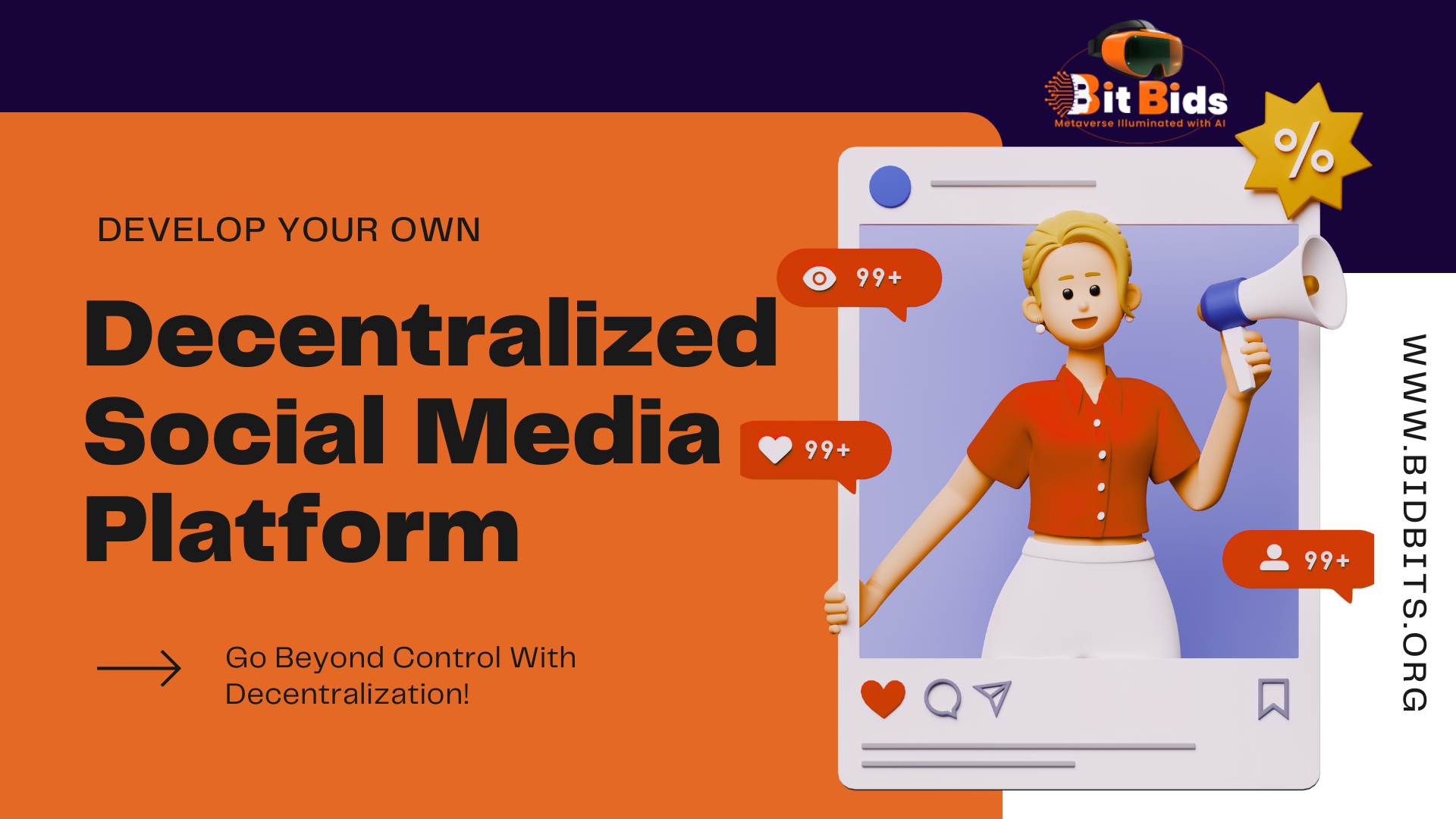Experience The Future With Our Decentralized Social Media Platform Development

Since the mid-1990s, social networks have become an integral part of our daily lives, connecting millions of users worldwide. However, the drawbacks of centralized platforms, such as data leaks, censorship, and privacy violations, have sparked a shift towards decentralized social networks (DSNs). Decentralized social media platforms have gained significant attention in recent years as they offer an alternative approach to the traditional social media platforms that dominate the internet landscape.
The shift towards blockchain-based, user-centric, and censorship-free social networks not only addresses current challenges but also opens new avenues for content creators to monetize their work. The future of decentralized social networks holds the potential to reshape the way we connect, share, and communicate in the digital ecosystem. In this blog, we’ll explore the concept of decentralized social media, its advantages, and present the best DSNs.
What Is Decentralized Social Media?
Decentralized social media is a game-changer that challenges traditional platforms by utilizing blockchain technology, which is the foundation of Web 3.0. Unlike centralized networks controlled by a single entity, decentralized social media operate on independent servers (nodes) connected through a peer-to-peer network. This eliminates the need for a central authority, providing users with increased security, privacy, and control over their data.
With blockchain’s immutable, secure, and transparent nature, decentralized social media empowers users to have complete control over their data, ensuring privacy and security. This shift from centralized to decentralized social media is paving the way for a more inclusive and democratic online world, where users are the owners and decision-makers.
Key Aspects Of Decentralized Social Media Platform Development
Blockchain Technology
Traditional platforms are susceptible to data breaches, exposing user information to potential hacks. Decentralized social media platforms utilize blockchain’s cryptographic methods and distributed node architecture to enhance security and protect user data from unauthorized access. Decentralized social media platforms leverage blockchain technology to ensure a distributed and tamper-resistant ledger. This enhances transparency, security, and trust among users.
Tokenization and Cryptocurrency
Decentralized social networks introduce new avenues for content monetization. Native cryptocurrencies and tokenization enable new monetization models. Content creators can be directly rewarded for their contributions, fostering a more sustainable ecosystem. Some platforms integrate their native cryptocurrencies to facilitate transactions, tipping, and incentivize content creation. This allows users to be rewarded for their contributions within the platform.
Interoperability and Global Accessibility
Decentralized platforms often aim for interoperability, enabling users to connect and share content seamlessly across different networks. This promotes a more open and interconnected social media ecosystem. Decentralized platforms can attract a global user base without the need for extensive localization efforts. The borderless nature of blockchain technology facilitates access to a diverse audience.
User Control
Unlike centralized platforms, decentralized social media gives users control over their data. Users can choose how much information to share and with whom, reducing the risk of unauthorized access and data exploitation. In decentralized social networks, users have control over their content consumption. Instead of being bombarded with paid publications, users can curate their feeds, choosing what they want to see. This user-centric approach stands in contrast to the algorithm-driven content delivery of traditional platforms.
Censorship Resistance
Decentralized platforms are designed to be resistant to censorship. Content is stored across multiple nodes, making it difficult for any single entity to control or manipulate information. Users have the freedom to create and share content without fear of censorship. Unlike centralized platforms, decentralized social media don’t have administrators with the authority to delete or manipulate published materials.
Development Steps for a Decentralized Social Media Platform
Define Objectives
Clearly outline the goals and use cases for the decentralized social media platform. Determine whether it will focus on community building or specific interests. Choose a suitable blockchain or distributed ledger technology that aligns with the platform’s requirements. Ethereum, EOS, and Binance Smart Chain are popular choices for decentralized social media development.
UI and UX Design
Design a User Interface (UI) and User Experience (UX) Design that offers a user-friendly interface ensuring a smooth user experience. Consider features such as customizable profiles, easy content sharing, and interactive engagement tools.
Application Development
Implement smart contracts to automate and enforce rules within the platform. Smart contracts can handle user authentication, content sharing, and reward distribution. If applicable, integrate a native cryptocurrency or leverage existing tokens for transactions within the platform. Develop a secure wallet system for users to manage their digital assets. Implement robust security protocols to protect user data and ensure the integrity of the platform. Utilize encryption, two-factor authentication, and other security best practices.
QA Testing
It is important to conduct extensive testing to identify and resolve any bugs that may exist in the decentralized social media platform. Perform both unit testing and end-to-end testing to ensure the decentralized social media platform’s reliability and security.
Launch
Launch the decentralized social media platform and focus on building a vibrant and engaged community. Encourage user feedback and iterate on the platform based on community suggestions.
Top 3 Decentralized Social Media Platform
Steemit
Steemit stands out as a decentralized social media platform built on the Steem blockchain. Unlike traditional platforms where content creators struggle to monetize their work, Steemit introduces a novel approach by rewarding users with STEEM tokens for both creating and curating content. This innovative reward system addresses the inherent challenges of content monetization, providing an alternative model that values user engagement and contribution.
The Steem blockchain, the backbone of Steemit, ensures transparency and immutability. Every transaction and reward distribution is recorded on the blockchain, fostering trust among users. Steemit’s decentralized nature also makes it resistant to censorship, offering a space where users have greater control over their content.
LBRY
LBRY takes a decentralized approach to content sharing, leveraging blockchain technology to empower creators and eliminate intermediaries. At the core of LBRY is its native cryptocurrency, providing a secure method for users to explore and support content creators. LBRY’s decentralized model allows creators to publish their content directly, without relying on centralized platforms that may impose restrictions or control distribution.
This not only democratizes content creation but also ensures that creators retain control over their intellectual property. Users on LBRY can explore a wide range of content and support creators by using the platform’s native cryptocurrency. The decentralized nature of LBRY fosters a sense of community as users actively participate in the discovery and promotion of content that aligns with their interests.
Hive
Hive is a social blockchain designed to power various decentralized applications (DApps) and provide a censorship-resistant and community-driven platform for content creation, social interaction, and gaming. It emerged as a fork of the Steem blockchain, emphasizing decentralization and community governance. Hive’s versatility extends beyond social media, as its blockchain supports various DApps catering to different interests, including content creation, blogging, and gaming. This diversity enhances user engagement and creates a multifaceted ecosystem where individuals with different preferences can find their place.
Conclusion
Decentralized social media platforms offer a transformative approach to social networking. It is the future as they address the privacy concerns, censorship issues, and centralized control of data that have become major concerns for users. This is the best time to invest in decentralized social media platform development by partnering with our reliable and reputed Dapp development company. BidBits is at the forefront of revolutionizing social media with its innovative, decentralized platform.
Our decentralized social media platform empowers users with unprecedented control over their data, fostering a transparent and secure environment for meaningful connections. Our team of dedicated developers is driven by a vision to create a decentralized social media experience that puts users first. As the adoption of decentralized social media platforms continues to grow, we can expect to see more innovation in this space, providing users with more control over their online experience in the future.

